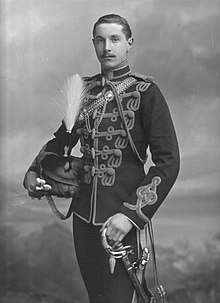Arthur Maxwell, 11th Baron Farnham
The Rt Hon. Arthur Kenlis Maxwell, 11th Baron Farnham, DSO (2 October 1879 – 5 February 1957), was British Army officer, an Irish Representative peer and a Nova Scotia baronet.

He was the son of The 10th Baron Farnham and Lady Florence Jane Taylour, a daughter of The 3rd Marquess of Headfort. On his father's death in November 1900, he succeeded as The 11th Baron Farnham (and 14th in the family Baronetcy) and inherited the Farnham Estate, County Cavan.
He was educated at the Royal Military Academy Sandhurst and received his first commission as second lieutenant in the 10th Hussars on 12 August 1899.[1] The regiment had embarked for South Africa to fight in the Second Boer War in November 1899, and Maxwell joined them in March 1900, travelling on the SS British Prince.[2] Shortly after arrival he was promoted to lieutenant on 1 April 1900. Following the end of the war in 1902 his regiment went to India. Lord Farnham joined almost 375 officers and men of the 10th Hussars who left Cape Town on the SS Lake Manitoba in September 1902, arriving at Bombay the following month, and was then stationed at Mhow in Bombay Presidency.[3] He was appointed to the Distinguished Service Order (DSO) in 1918 for his service in World War I.[4]
On 18 December 1908, he was elected an Irish Representative peer. During the First World War, he was Lieutenant-Colonel of the North Irish Horse.[5] He sat in the House of Lords as a member of the Irish Unionist Alliance, and became its closing leader of Southern Unionists after the 1919 split in the party and which ceased operations after the Anglo-Irish Treaty, 1921.
Lord Farnham married on 8 October 1903 Aileen Selina, daughter of Charles Purdon Coote and Lydia Wingfield-Digby. His son, Somerset, died of wounds in 1942 at the Battle of El Alamein, and so on his own death in 1957 in a Dublin nursing home, his titles and his estate, which UK part amounted to £22,810,[6] passed to his grandson, Barry. His granddaughter Sheelin married The 3rd Viscount Knollys.
Notes
- Hart′s Army list, 1903
- "The War - Embarcation of Troops". The Times (36088). London. 13 March 1900. p. 6.
- "The Army in South Africa - Troops returning home". The Times (36884). London. 27 September 1902. p. 10.
- . . Dublin: Alexander Thom and Son Ltd. 1923. p. – via Wikisource.
- "National Library of Ireland - Collection List No. 95 - FARNHAM PAPERS" (PDF). National Library of Ireland. Retrieved 18 August 2012.
- https://probatesearch.service.gov.uk/ Calendar of probates and administrations
References
- Kidd, Charles, Williamson, David (editors). Debrett's Peerage and Baronetage (1990 edition). New York: St Martin's Press, 1990. (ISBN 033338847X),
- Leigh Rayment's Peerage Pages
- Leigh Rayment's list of baronets
- Lundy, Darryl. "p. 3213 § 32127 - Sir Arthur Kenlis Maxwell, 11th Baron Farmham". The Peerage.
- . . Dublin: Alexander Thom and Son Ltd. 1923. p. – via Wikisource.
External links
| Peerage of Ireland | ||
|---|---|---|
| Preceded by Somerset Maxwell |
Baron Farnham 1900–1957 |
Succeeded by Barry Maxwell |
| Baronetage of Nova Scotia | ||
| Preceded by Somerset Maxwell |
Baronet (of Calderwood) 1900–1957 |
Succeeded by Barry Maxwell |